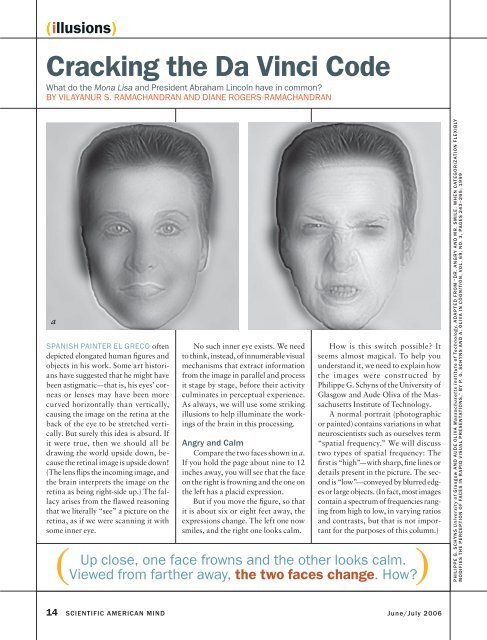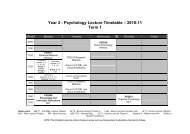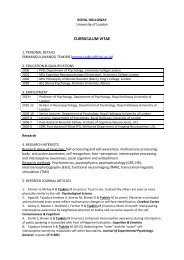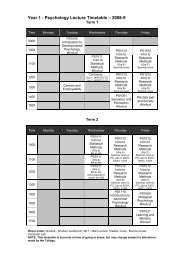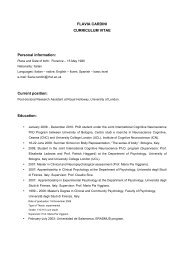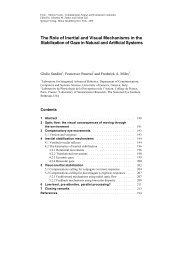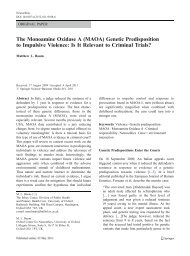Cracking the Da Vinci Code
Cracking the Da Vinci Code
Cracking the Da Vinci Code
Create successful ePaper yourself
Turn your PDF publications into a flip-book with our unique Google optimized e-Paper software.
(illusions)<br />
<strong>Cracking</strong> <strong>the</strong> <strong>Da</strong> <strong>Vinci</strong> <strong>Code</strong><br />
What do <strong>the</strong> Mona Lisa and President Abraham Lincoln have in common<br />
BY VILAYANUR S. RAMACHANDRAN AND DIANE ROGERS-RAMACHANDRAN<br />
a<br />
SPANISH PAINTER EL GRECO often<br />
depicted elongated human figures and<br />
objects in his work. Some art historians<br />
have suggested that he might have<br />
been astigmatic—that is, his eyes’ corneas<br />
or lenses may have been more<br />
curved horizontally than vertically,<br />
causing <strong>the</strong> image on <strong>the</strong> retina at <strong>the</strong><br />
back of <strong>the</strong> eye to be stretched vertically.<br />
But surely this idea is absurd. If<br />
it were true, <strong>the</strong>n we should all be<br />
drawing <strong>the</strong> world upside down, because<br />
<strong>the</strong> retinal image is upside down!<br />
(The lens flips <strong>the</strong> incoming image, and<br />
<strong>the</strong> brain interprets <strong>the</strong> image on <strong>the</strong><br />
retina as being right-side up.) The fallacy<br />
arises from <strong>the</strong> flawed reasoning<br />
that we literally “see” a picture on <strong>the</strong><br />
retina, as if we were scanning it with<br />
some inner eye.<br />
No such inner eye exists. We need<br />
to think, instead, of innumerable visual<br />
mechanisms that extract information<br />
from <strong>the</strong> image in parallel and process<br />
it stage by stage, before <strong>the</strong>ir activity<br />
culminates in perceptual experience.<br />
As always, we will use some striking<br />
illusions to help illuminate <strong>the</strong> workings<br />
of <strong>the</strong> brain in this processing.<br />
Angry and Calm<br />
Compare <strong>the</strong> two faces shown in a.<br />
If you hold <strong>the</strong> page about nine to 12<br />
inches away, you will see that <strong>the</strong> face<br />
on <strong>the</strong> right is frowning and <strong>the</strong> one on<br />
<strong>the</strong> left has a placid expression.<br />
But if you move <strong>the</strong> figure, so that<br />
it is about six or eight feet away, <strong>the</strong><br />
expressions change. The left one now<br />
smiles, and <strong>the</strong> right one looks calm.<br />
How is this switch possible It<br />
seems almost magical. To help you<br />
understand it, we need to explain how<br />
<strong>the</strong> images were constructed by<br />
Philippe G. Schyns of <strong>the</strong> University of<br />
Glasgow and Aude Oliva of <strong>the</strong> Massachusetts<br />
Institute of Technology.<br />
A normal portrait (photographic<br />
or painted) contains variations in what<br />
neuroscientists such as ourselves term<br />
“spatial frequency.” We will discuss<br />
two types of spatial frequency: The<br />
first is “high”—with sharp, fine lines or<br />
details present in <strong>the</strong> picture. The second<br />
is “low”—conveyed by blurred edges<br />
or large objects. (In fact, most images<br />
contain a spectrum of frequencies ranging<br />
from high to low, in varying ratios<br />
and contrasts, but that is not important<br />
for <strong>the</strong> purposes of this column.)<br />
(<br />
Up close, one face frowns and <strong>the</strong> o<strong>the</strong>r looks calm.<br />
)<br />
Viewed from far<strong>the</strong>r away, <strong>the</strong> two faces change. How<br />
PHILIPPE G. SCHYNS University of Glasgow AND AUDE OLIVA Massachusetts Institute of Technology, ADAPTED FROM “DR. ANGRY AND MR. SMILE: WHEN CATEGORIZATION FLEXIBLY<br />
MODIFIES THE PERCEPTION OF FACES IN RAPID VISUAL PRESENTATIONS,” BY P. G. SCHYNS AND A. OLIVA IN COGNITION, VOL. 69, NO. 3, PAGES 243–265; 1999<br />
14 SCIENTIFIC AMERICAN MIND June/July 2006
(<br />
Squint, and <strong>the</strong> image blurs, eliminating <strong>the</strong> sharp edges.<br />
)<br />
Presto! Lincoln becomes instantly recognizable.<br />
REPRINTED WITH PERMISSION OF LUCENT TECHNOLOGIES, INC./BELL LABS (b); GALA CONTEMPLATING THE MEDITERRANEAN SEA WHICH AT TWENTY METRES BECOMES THE PORTRAIT<br />
OF ABRAHAM LINCOLN (HOMAGE TO ROTHKO); MUSEO DALÍ/BRIDGEMAN ART LIBRARY; © 2006 SALVADOR DALÍ, GALA-SALVADOR DALÍ FOUNDATION/ARS, NEW YORK (c )<br />
Using computer algorithms,<br />
we can process a<br />
normal portrait to remove<br />
ei<strong>the</strong>r high or low spatial<br />
frequencies. For instance, if<br />
we remove high frequencies,<br />
we get a blurred image that<br />
is said to contain “low spatial<br />
frequencies in <strong>the</strong> Fourier<br />
space.” (This ma<strong>the</strong>matical<br />
description need not<br />
concern us fur<strong>the</strong>r here.) In<br />
o<strong>the</strong>r words, this procedure<br />
of blurring is called low-pass<br />
filtering, because it filters out<br />
<strong>the</strong> high spatial frequencies<br />
(sharp edges or fi ne lines)<br />
and lets through only low<br />
frequencies. High-pass filtering,<br />
<strong>the</strong> opposite procedure,<br />
retains sharp edges and outlines<br />
but removes large-scale<br />
variations. The result looks<br />
a bit like an outline drawing<br />
without shading.<br />
These types of computerprocessed<br />
images are com-<br />
c<br />
bined toge<strong>the</strong>r, in an atypical<br />
manner, to create <strong>the</strong> mysterious<br />
faces shown in a. The researchers began<br />
with normal photographs of three<br />
faces: one calm, one angry and one<br />
smiling. They filtered each face to obtain<br />
both high-pass (containing sharp,<br />
fine lines) and low-pass (blurred, so as<br />
to capture large-scale luminance variations)<br />
images. They <strong>the</strong>n combined<br />
<strong>the</strong> high-pass calm face with <strong>the</strong> lowpass<br />
smiling face to obtain <strong>the</strong> left image.<br />
For <strong>the</strong> right image, <strong>the</strong>y overlaid<br />
<strong>the</strong> high-pass frowning face with <strong>the</strong><br />
low-pass calm face.<br />
What happens when <strong>the</strong> figures are<br />
viewed close-up And why do <strong>the</strong> expressions<br />
change when you move <strong>the</strong><br />
page away To answer <strong>the</strong>se questions,<br />
we need to tell you two more things<br />
about visual processing. First, <strong>the</strong> image<br />
needs to be close for you to see <strong>the</strong><br />
sharp features. Second, sharp features,<br />
when visible, “mask”—or deflect attention<br />
away from—<strong>the</strong> large-scale objects<br />
(low spatial frequencies).<br />
So when you bring <strong>the</strong> picture near,<br />
<strong>the</strong> sharp features become more visible,<br />
masking <strong>the</strong> coarse features. As a<br />
result, <strong>the</strong> face on <strong>the</strong> right looks like<br />
it is frowning and <strong>the</strong> one on <strong>the</strong> left,<br />
like it is relaxed. You simply do not<br />
notice <strong>the</strong> opposite emotions that <strong>the</strong><br />
low spatial frequencies convey. Then,<br />
when you move <strong>the</strong> page far<strong>the</strong>r away,<br />
your visual system is no longer able to<br />
resolve <strong>the</strong> fine details. So <strong>the</strong> expression<br />
conveyed by <strong>the</strong>se fi ne features<br />
disappears, and <strong>the</strong> expression conveyed<br />
by low frequencies is unmasked<br />
and perceived.<br />
The experiment shows vividly an<br />
idea originally postulated by Fergus<br />
Campbell and John Robson of <strong>the</strong><br />
University of Cambridge: information<br />
b<br />
from different spatial scales<br />
is extracted in parallel by<br />
various neural channels,<br />
which have wide ranges of<br />
receptive field sizes. (The<br />
receptive field of a visual<br />
neuron is <strong>the</strong> part of <strong>the</strong> visual<br />
field and corresponding<br />
tiny patch of retina to<br />
which a stimulus needs to<br />
be presented to activate it.)<br />
It also shows that <strong>the</strong> channels<br />
do not work in isolation<br />
from one ano<strong>the</strong>r. Ra<strong>the</strong>r <strong>the</strong>y<br />
interact in interesting ways (for example,<br />
<strong>the</strong> sharp edges picked up by small<br />
receptive fields mask <strong>the</strong> blurred largescale<br />
variations signaled by large receptive<br />
fields).<br />
Honest Abe<br />
Experiments of this kind go back<br />
to <strong>the</strong> early 1960s, when Leon Harmon,<br />
<strong>the</strong>n working at Bell Laboratories,<br />
devised <strong>the</strong> famous Abraham<br />
Lincoln effect. Harmon produced <strong>the</strong><br />
picture of Honest Abe (b) by taking a<br />
regular picture and digitizing it into<br />
coarse pixels (picture elements). Even<br />
when viewed close-up, <strong>the</strong>re is enough<br />
information in <strong>the</strong> blocky brightness<br />
variations to recognize Lincoln. But<br />
<strong>the</strong>se data, as we noted already, are<br />
masked by <strong>the</strong> sharp edges of <strong>the</strong> pixels.<br />
When you move far away from <strong>the</strong><br />
www.sciammind.com SCIENTIFIC AMERICAN MIND 15
(illusions)<br />
( )<br />
The elusive smile can be seen only when you look away<br />
from <strong>the</strong> mouth. Attend to it out of <strong>the</strong> corner of your eye.<br />
d<br />
photograph or squint, <strong>the</strong> image blurs,<br />
eliminating <strong>the</strong> sharp edges. Presto!<br />
Lincoln becomes instantly recognizable.<br />
The great artist Salvador <strong>Da</strong>lí<br />
was sufficiently inspired by this illusion<br />
to use it as a basis for his paintings,<br />
an unusual juxtaposition of art<br />
and science (c).<br />
Mysterious Mona Lisa<br />
Finally, consider <strong>the</strong> mysterious<br />
smile of Leonardo da <strong>Vinci</strong>’s Mona<br />
Lisa. Philosophers and art historians<br />
who specialize in aes<strong>the</strong>tics often refer<br />
to her expression as “enigmatic” or<br />
“elusive,” mainly because <strong>the</strong>y do not<br />
understand it. Indeed, we wonder<br />
whe<strong>the</strong>r <strong>the</strong>y prefer not to understand<br />
it, because <strong>the</strong>y seem to resent any attempts<br />
to explain it scientifically, apparently<br />
for fear that such analysis<br />
might detract from its beauty.<br />
But recently neurobiologist Margaret<br />
Livingstone of Harvard Medical<br />
School made an intriguing observation;<br />
she cracked <strong>the</strong> da <strong>Vinci</strong> code,<br />
you might say. She noticed that when<br />
she looked directly at Mona Lisa’s<br />
mouth (d, center panel), <strong>the</strong> smile was<br />
not apparent (quite a disappointment).<br />
Yet as she moved her gaze away<br />
from <strong>the</strong> mouth, <strong>the</strong> smile appeared,<br />
beckoning her eyes back. Looking<br />
again at <strong>the</strong> mouth, she saw that <strong>the</strong><br />
smile disappeared again. In fact, she<br />
noted, <strong>the</strong> elusive smile can be seen<br />
only when you look away from <strong>the</strong><br />
mouth. You have to attend to it out of<br />
<strong>the</strong> corner of your eye, ra<strong>the</strong>r than fixating<br />
on it directly. Because of <strong>the</strong><br />
unique shading (placement of low<br />
spatial frequencies) at <strong>the</strong> corners of<br />
<strong>the</strong> mouth, a smile is perceived only<br />
when <strong>the</strong> low spatial frequencies are<br />
dominant—that is, when you look indirectly<br />
at <strong>the</strong> masterpiece.<br />
To confi rm this notion, she performed<br />
a low-pass filtering (left panel)<br />
and a high-pass filtering (right panel)<br />
of <strong>the</strong> Mona Lisa. Notice that with<br />
<strong>the</strong> low-pass (blurred) image <strong>the</strong> smile<br />
is more obvious than in <strong>the</strong> original—<br />
it can be seen even if you look directly<br />
at <strong>the</strong> mouth. With <strong>the</strong> high-pass (outlinelike)<br />
image, however, no smile is<br />
apparent, even if you look away from<br />
<strong>the</strong> mouth. Putting <strong>the</strong>se two images<br />
(Fur<strong>the</strong>r Reading)<br />
back toge<strong>the</strong>r restores <strong>the</strong> original<br />
masterpiece and <strong>the</strong> elusive nature of<br />
<strong>the</strong> smile. As with <strong>the</strong> changing faces,<br />
we can now better appreciate what<br />
Leonardo seems to have stumbled on<br />
and fallen in love with—a portrait<br />
that seems alive because its fleeting<br />
expression (thanks to quirks of our<br />
visual system) perpetually tantalizes<br />
<strong>the</strong> viewer.<br />
Taken collectively, <strong>the</strong>se experiments<br />
show that <strong>the</strong>re is more to perception<br />
than what meets <strong>the</strong> eye. More<br />
specifically, <strong>the</strong>y demonstrate that information<br />
at different scales, such as<br />
fine versus coarse, may be extracted<br />
initially from an image by separate<br />
neural channels and recombined at<br />
different stages of processing to create<br />
<strong>the</strong> final impression of a single unified<br />
picture in your mind. M<br />
VILAYANUR S. RAMACHANDRAN and<br />
DIANE ROGERS-RAMACHANDRAN are at<br />
<strong>the</strong> Center for Brain and Cognition at <strong>the</strong><br />
University of California, San Diego.<br />
◆ Dr. Angry and Mr. Smile: When Categorization Flexibly Modifies <strong>the</strong> Perception<br />
of Faces in Rapid Visual Presentations. Philippe G. Schyns and Aude Oliva in Cognition,<br />
Vol. 69, No. 3, pages 243–265; 1999.<br />
MARGARET LIVINGSTONE Harvard Medical School<br />
16 SCIENTIFIC AMERICAN MIND June/July 2006


